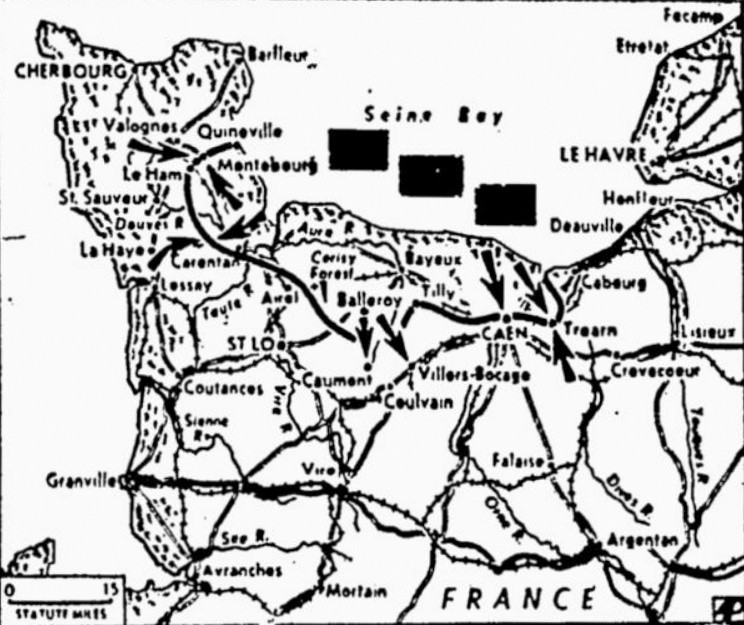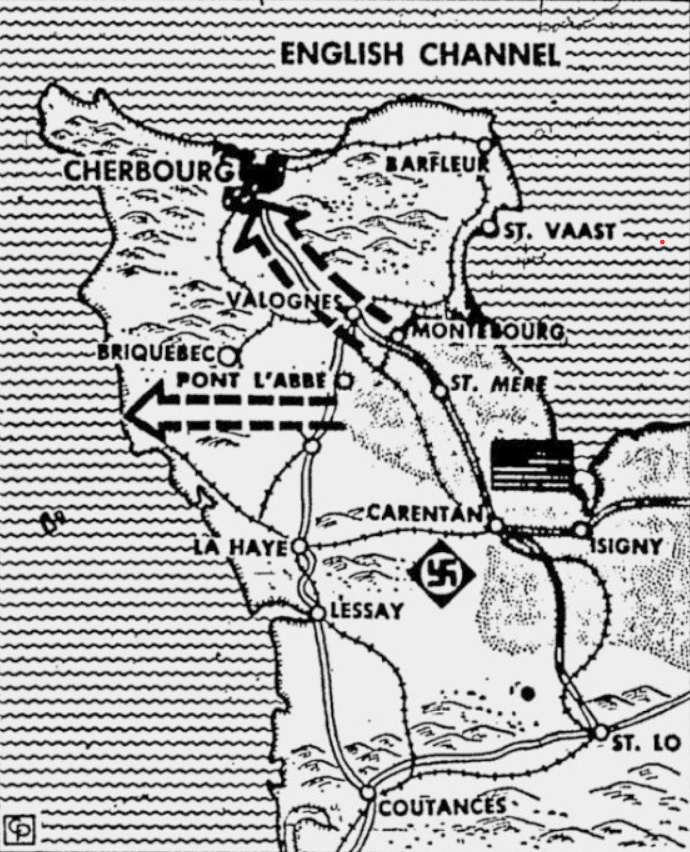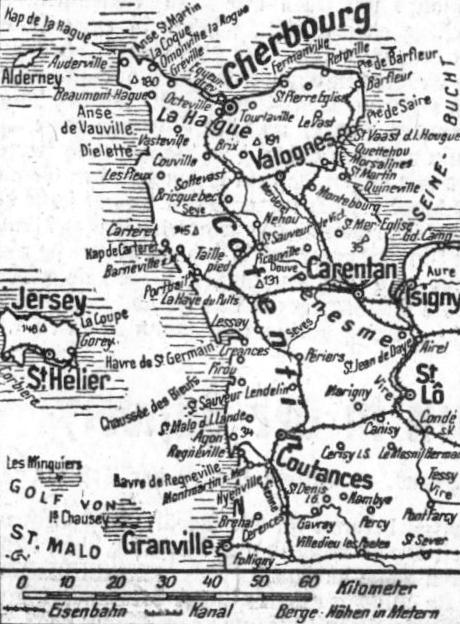The Free Lance-Star (June 15, 1944)
YANKS NEARLY CUT PENINSULA
Push ahead despite strong Nazi defense
Germans reported to be using 600 tanks to spearhead violent counterattacks; British give ground as enemy gains new power
Allies drive at center: Arrows show Allied drives and German counterattacks on the Normandy beachhead (black line). While the Allies drove at the center, the Nazis concentrated their main attacks at the ends of the battle line, now about 100 miles in length.
SHAEF, London, England (AP) –
U.S. troops have surged powerfully ahead in their stab into the Cherbourg neck, Allied headquarters announced today, and Berlin reported that less than six miles separated the spearhead from the West Coast communications linking Cherbourg with France.
The gains were hammered out in spite of furious counterattacks all along the 100-mile invasion front in which the Germans had thrown about 20 divisions and 600 tanks.
Allied headquarters reported that U.S. infantry and parachute troops, supported by tanks had scored further gains west of Carentan, said Allied soldiers were holding firm everywhere else despite the massive nature of the German counterstroke and were inflicting heavy losses on the enemy.
British retire
This was after it was acknowledged that the British at the eastern end of the line had been forced to give up Troarn, their anchor nine miles east of Caen, and Villers-Bocage, one of their two advance points 15 miles southwest of Caen.
Further heavy counterattacks in the Villers-Bocage area were turned back yesterday evening, headquarters said, and the British were still secure in their hold on Caumont, their other most advanced point, 20 miles southwest of Caen.
Seventeen German tanks, including eight 60-ton Tigers, were knocked out in the fierce armored battling yesterday, headquarters said. The other eight tanks were Panthers armed with 75mm guns.
At the western end of the line, the Americans first moved forward on a nine-mile front to the Les Sablons-Baupte area, south of Sainte-Mère-Église and only about seven miles from high ground overlooking La Haye-du-Puits on the west coast road and rail line leading to Cherbourg.
The Berlin radio commentator, Ludwig Sertorius, then reported that they had gained another three and a half miles to the west, reaching Prétot which is less than six miles from La Haye-du-Puits itself.
Vise closing on Cherbourg
The close-up of the Cherbourg Peninsula battleground shows how U.S. invasion armies were cutting halfway across the peninsula to Pont-l’Abbé, a point about eight miles northeast of the enemy communications center of La Haye-du-Puits. Despite new and stiff German resistance, particularly around Carentan, U.S. forces hoped to press ahead toward Valognes, a crucial communications center, and finally cut off the German garrison.
Heavy street battle
The Americans also fought their way back into Montebourg, 14 miles from Cherbourg and headquarters said street fighting was in progress. But the fighting here was fluid, and the Germans in midafternoon claimed they were again in possession of the town.
U.S. troops were also engaged in heavy fighting in the Pont-l’Abbé area, four miles north of Prétot, and along the road from Montebourg to Quinéville on the coast.
The Americans hammered out gains both in the Pont-l’Abbé area and around Quinéville, which represents the Allied right flank, headquarters said.
The heavy nature of the fighting was plainly indicated by the German High Command, which said the battle is “approaching a climax” and growing more violent every day with the Allies hitting hard in all directions to enlarge their bridgehead.
The German communiqué added:
Among salvos of heaviest naval guns, incessant air attacks and with freshly brought up infantry and tank forces being thrown into action on both sides, the battle is approaching a climax.
Push toward Cherbourg
The U.S. advance was on a nine-mile front westward from Carentan toward high ground controlling the last German roads leading to Cherbourg.
Violent German reaction to the threat to the lifeline was expected, and it was likely that further U.S. advances would be only after the costliest fighting.
The Yankees plunged to the Les Sablons-Baupte area, south of Sainte-Mère-Église and west of Carentan. Seven miles to the westward is high ground overlooking La Haye-du-Puits, through which runs the last remaining major north-south highway on the peninsula still in German hands.
The advance placed the Americans nearly halfway across the peninsula at its narrowest point.
Hand-to-hand fighting surged between Germans and troops of the U.S. 4th Infantry Division in the streets of Montebourg, 14 miles southeast of Cherbourg.
U.S. artillery was shelling the road from Montebourg to Valognes to the northwest, and the doughboys controlled the road from Quinéville, on the coast, to Montebourg, but the town itself changed hands from hour to hour.
U.S. airborne troops spearheaded the fighting around Carentan and besides pushing to the west shoved the Germans back more than a mile south of the town.
Heavy troop movement
Allied fliers reported more movement on the roads behind the German lines last night than at any time since D-Day.
While a great weight of Allied bombs was being thrown against this movement, an announcement came that several hundred RAF four-engined Lancasters and a fighter escort, in a quick switch to American bombing tactics, had blasted German E-boat pens at Le Havre before dusk last evening with six-ton “factory busters.” It was the RAF’s heaviest daylight attack of the war. A second assault was directed against the same targets during the night.
Enemy broadcasts reacted to the new Allied attention of Le Havre, lying just east of the beachhead, with surmises that it portended a forthcoming land move in that direction.
East of Villers-Bocage to Troarn, beyond battered and besieged Caen, great tank battles raged with undiminished intensity into their fourth day. The Germans were using elements of four armored divisions.
Send in reserves
With the German counterattacks mounting in fury, there were indications that Field Marshal Karl Gerd von Rundstedt had decided to draw off some of his reserves in other portions of France to meet the Allied thrusts.
Appearance of the second German panzer division – the best armored unit in the German Army – indicated the Germans were making a supreme effort to seal off the Allied beachhead.
The next two or three days are expected to show whether the German High Command has been forced to throw reserves into the battle piecemeal – as in the past nine days – or has been able to keep them intact for a final, all-out counterattack.



